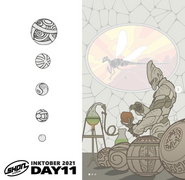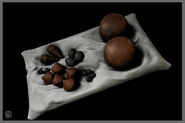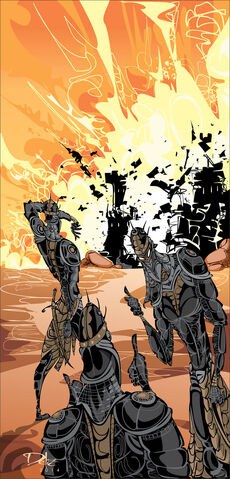
Interpretation of the effect of Moranth munitions by dejan-delic
Moranth munitions were explosives developed by the Moranth from Tiste Edur alchemies[1] and employed by the Malazan Empire's military, being one of the main advantages it held over its rivals.
The Moranth were fanatics when it came to precision and no variation was allowed within a class of munitions.[2]
Background[]
The munitions were widely recognized as having revolutionized the Malazan army's military tactics.[3] The Malazan world's technology base did not include gunpowder or any other modern artillery, with the exception of those munitions provided by the Moranth.
The Empire discovered the Moranth living in an area of the continent of Genabackis known as the Cloud Forest. During the Genabackis Campaign, Tayschrenn, Aragan, and Onos T'oolan negotiated a treaty with the Moranth to supply munitions to the Malazan Empire.[2]
Moranth tactics involved dropping munitions from the backs of the giant dragonflies they rode into battle, but the Malazan Army modified them into projectiles. The first munitions the Malazans had access to were delivered to the Malazan 2nd Army at its camp south of Malyntaeas a week before the march on Mott. The Bridgeburner, Whiskeyjack, subsequently passed them on to the sappers, Hedge and Fiddler, for experimentation.[2] The two perfected the techniques involved in deploying munitions, bestowed many of names by which the different types of munitions were still known, and remained the best sappers in the army.[2] There had once been entire companies of sappers until a sapper dropped a munition and blew an entire company to pieces.[4]
Moranth munitions had outer shells composed of clay or exquisite glass, built to exacting standards with no room for variation.[2] They were filled with unidentified powders which exploded upon contact with air. The various types of explosives had different shapes ranging from cylinders and cones to spheres. The Malazan Army had already perfected a crossbow for its military including larger types for use with most Moranth munitions. The Bridgeburner sapper, Fiddler, had had an armorer make a very limited quantity of an even more powerful version for use with cussers in particular. There were several types of munitions, each with their own purpose and structure.
Burners[]
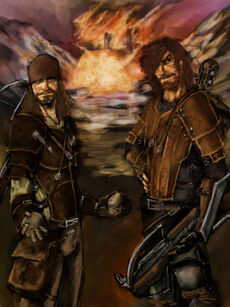
'Hedge and Fidd' by slaine69
Burners were composed of glass cylinders filled with a different type of explosive than other munitions, comparable to real-life incendiary grenades. Upon detonation, burners created a fireball designed to burn enemy troops and supplies. They were less deadly than Sharpers but could be used more strategically to create havoc among the enemy. They were frequently loaded onto large crossbows to allow for more range, and were often used in conjunction with crackers to demolish fortifications. Burners were less likely to be used during night operations when stealth mattered as they lit up the battlefield.[5] They reacted catastrophically to otataral.[6]
Crackers[]
Crackers were a very specific variety of explosive used for the demolition of buildings.[2] They were the most durable form of munition, able to be hammered without detonation, comparable to a block of real-life military C-4. They were made of fired clay, shaped like cones or wedges that could be hammered into hard-packed earth or into cracks or gaps in walls.[2] Crackers exploded with a loud cracking noise, leading to their name.
Cussers[]
Clay shells filled with yellow incendiary powder and shards of iron,[7] cussers were the largest, most volatile, and most deadly of the munitions,[5] comparable to a real-life satchel charge in potential destructiveness. A single cusser was capable of making the intersection of four streets impassable.[5] Their name came from the only adequate reaction to their effects--cussing.[citation needed] Cussers required much more delicate handling than other munitions as they were extremely difficult to use on an enemy without also affecting the user. Attempts to launch them using catapults caused them to detonate,[2] as did using a conventional crossbow to deliver them, and they could not be thrown by hand as the blast radius was too wide for the thrower to clear after launching one. Anything within thirty paces of an exploding cusser was "diced liver".[5] Due to their limitations, several alternative methods of delivery and detonation were developed:
Modified crossbow[]
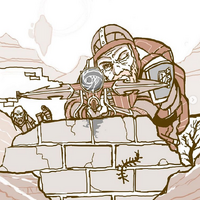
Moranth munition by Shadaan
The most common method of delivery was launching with a modified crossbow. The crossbow was much larger than a conventional bow and used a special cradle to hold the munition. These had an effective range of approximately 30 paces, which was close enough that one needed to take cover from debris.
Remote detonation[]
A cusser or group of cussers was planted near the target. The sapper then retreated out of range and fired a crossbow loaded with a sharper or burner into the region causing the cusser(s) to explode.
Fuse[]
A cusser was rigged with a drop of acid that slowly dissolved the munition's wax plug[5] or clay coating while the sapper retreated out of range. The amount and placement of acid affected the timing of the explosion and was a rare art with little room for error. Two drops of acid took about ten heartbeats to eat through a wax plug.[5]
Trip wire[]
This was used in ambushes and traps for enemy troops. A tripwire was stretched across a path tied to a cusser on each end. The cussers were balanced on a nearby object. When an enemy sprang the tripwire, the munitions fell and detonated. This was not practical in open areas nor during daylight.
The Drum[]
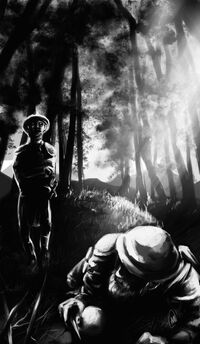
Interpretation of Fiddler preparing the Drum by Puck
A legendary method of deploying cussers used solely by the Bridgeburners, Fiddler and Hedge, which mimicked a land mine. Holes were first dug in a chosen pattern, depending on the area. The main trigger cusser was then shaved down on one side until the clay was paper thin. A sharp stone was then placed on the thin area and the cusser was buried. The remaining cussers were then buried in the desired formation, but were not shaved as thin as the first. When the enemy approached, their footfalls resonated through the ground causing the stone to puncture the clay and detonate the trigger cusser. This cusser was placed ahead of the others so that when it was triggered enemy troops would already be standing on top of the others when they went off in a chain reaction.[2]
Cussers were manufactured twelve to a crate. For reasons known only to the Moranth, every thirteenth crate contained an extra inert cusser empty of explosive powder.[8]
Flamers[]
Flamers engulfed their target in a raging liquid fire and were capable of being fired from a crossbow.[9][10] They reacted catastrophically to otataral.[6]
Knucklers[]
Possibly a later addition to the Malazan arsenal, knucklers were used to scare horses.[11]
Melters[]
Melters were similar to burners in that they did not explode like the rest of the Moranth munitions. Instead the melter engulfed whatever it hit in white flames that, as the name suggested, almost seemed to melt away parts of the target.[12]
Redbolts[]
These munitions were mentioned in The Crippled God. Ganoes Paran raided a Moranth warehouse where he found that there was a whole class of munitions which were exclusively used by the Moranth and had never been made available to the Malazan sappers.[13] They were like fireworks, in that they had a long range and were lit with a fuse. Upon impact with an object, they produced a detonation even greater than that of a cusser.[citation needed] The trails they produced when fired were red, hence their name, Redbolts.
Sharpers[]
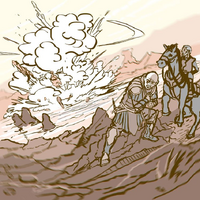
Moranth Munition Trap by Shadaan
These were the most commonly used type of explosive by the Malazan Army, due to their versatility. They were small cones composed of fired clay and contained shards of metal[14] designed to act as shrapnel. They were small and light enough to throw without causing damage to the thrower, comparable to a real-life hand grenade. Sharpers were so named because they tended to pepper the thrower with slivers of iron shrapnel and make their ears bleed when detonated too close.[2] They were commonly loaded onto large specially-modified crossbows to be fired at distant targets. Like cussers, the Moranth stored thirteen sharpers to a crate with the thirteenth sharper left inert.[15][16]
Smokers[]
As the name suggests, smokers released large clouds of smoke, akin to a modern smoke bomb. They were used tactically to create confusion.[17]
Sparkers[]
Mentioned in Gardens of the Moon by Fiddler, but never afterwards.[18] It could be a nickname for a cracker.
Wall-breakers[]
These were a combination of cussers and crackers used to breach particularly strong walls or fortifications. Two cussers were strapped together along with two spike-shaped crackers attached to their base. The bundle was placed within an angled hole at the base of the wall to be destroyed and was triggered by the timed application of acid to the munition's wax plug.[19]
In Gardens of the Moon[]
The Green Moranth delivered two crates of munitions to Whiskeyjack and his squad prior to their mission in Darujhistan. The crate contained everything from cussers all the way down to smokers.[20]
In Reaper's Gale[]
Some munitions, like the cussers, handily proved capable of causing deadly injuries to dragons.[21][22]
In Toll the Hounds[]
Torvald Nom received a dozen Blue Moranth handheld sharpers which were like works of art, perfect porcelain globes lacquered with a thick, mostly transparent gloss that was nevertheless faintly cerulean.[23][24] When activated in combat, the Blue Moranth sharpers behaved remarkably different from any sharper previously depicted, creating "a bulging, sloshing sphere" filled with water.[25]
In The God is Not Willing[]
(Information needed)
Fan art gallery[]
Notes and references[]
- ↑ Memories of Ice, Chapter 10
- ↑ 2.0 2.1 2.2 2.3 2.4 2.5 2.6 2.7 2.8 2.9 Reaper's Gale, Chapter 17, UK BCA edition p.531-534
- ↑ Reaper's Gale, Chapter 17, US HC p.502
- ↑ Memories of Ice, Chapter 21, UK MMPB p.906
- ↑ 5.0 5.1 5.2 5.3 5.4 5.5 Memories of Ice, Chapter 17
- ↑ 6.0 6.1 House of Chains, Chapter 23, US SFBC p.744
- ↑ Reaper's Gale, Chapter 17, US HC p.492
- ↑ Toll the Hounds, Chapter 11, US SFBC p.443
- ↑ Deadhouse Gates, Chapter 7, US HC p.192-193
- ↑ Deadhouse Gates, Chapter 18, US HC p.481
- ↑ The God is Not Willing, Chapter 2, US HC p.47
- ↑ Return of the Crimson Guard, Book 3 Chapter 1
- ↑ The Crippled God, Chapter 22, UK HB p.685
- ↑ Deadhouse Gates, Chapter 12, US HC p.319
- ↑ Toll the Hounds, Chapter 15, US SFBC p.611-612
- ↑ Toll the Hounds, Chapter 21, US SFBC p.855
- ↑ The Bonehunters, Chapter 7, US SFBC p.301
- ↑ Gardens of the Moon, Chapter 11
- ↑ The Bonehunters, Chapter 7, US SFBC p.287
- ↑ Gardens of the Moon, Chapter 8, UK MMPB p.259
- ↑ Reaper's Gale, Chapter 23
- ↑ Reaper's Gale, Chapter 24
- ↑ Toll the Hounds, Chapter 15, US SFBC p.611-612
- ↑ Toll the Hounds, Chapter 21, US SFBC p.855
- ↑ Toll the Hounds, Chapter 21, US SFBC p.855-856

